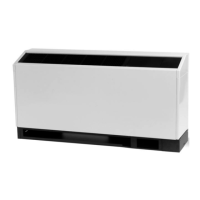21
WSHP-PRC004-EN
Features and
Benefits
Tracer ZN.510
Controls
Tracer ZN.510 features include:
Compressor Operation
The compressor is cycled on and off to
meet heating or cooling zone demands.
Single compressor units use the unit
capacity and pulse width modulation
(PWM) logic along with minimum on/off
timers to determine the compressor’s
operation. The compressor is controlled
ON for longer periods as capacity
increases and shorter periods as
capacity decreases.
Random Start
To prevent all of the units in a building
from energizing major loads at the same
time, the controller observes a random
start from 0 to 25 seconds. This timer
halts the controller until the random start
time expires.
Reversing Valve Operation
For cooling, the reversing valve output is
energized simultaneously with the
compressor. It will remain energized
until the controller turns on the
compressor for heating. At this time, the
reversing valve moves to a de-energized
state. In the event of a power failure or
controller OFF situation, the reversing
valve output will default to the heating
(de-energized) state.
Fan Operation
The supply air fan operates at the fan
switch selected speed in the occupied or
occupied standby mode. When switch is
set to AUTO, the fan is configured for
cycling ON with heating or cooling. The
fan will run for 30 seconds beyond
compressor shutdown in both occupied
and unoccupied mode.
Filter Maintenance Timer
The controller’s filter status is based on
the unit fan’s cumulative run hours. The
controller compares the fan run time
against an adjustable fan run hours limit
and recommends unit maintenance as
required.
Data Sharing
The Tracer ZN.510 controller is capable
of sending or receiving data (set points,
fan request, or space temperature) to
and from other controllers on the
communication link. This allows multiple
units to share a common space
temperature sensor in both stand-alone
and building automation applications.
Night Setback
The four operations of the Tracer ZN.510
controller include occupied, occupied
standby, occupied bypass and
unoccupied.
In an occupied situation, the controller
uses occupied heating and cooling set
points to provide heating and cooling to
the building. This occupied operation is
normally used during the daytime hours
when the building is at the highest
occupancy level.
In an occupied standby situation, the
controllers heating and cooling set
points are usually much wider than the
occupied set points. This occupied
standby operation is used during
daytime hours when people are not
present in the space (such as lunchtime
or recess). To determine the space
occupancy, an occupancy sensor is
applied.
In an unoccupied situation, the controller
assumes the building is vacant, which
normally falls in evening hours when a
space may be empty. In the unoccupied
mode, the controller uses the default
unoccupied heating and cooling set
points stored in the controller. When the
building is in unoccupied mode,
individual units may be manually placed
into timed override of the unoccupied
mode at the units wall sensor. During
timed override, the controller interprets
the request and initiates the occupied
setpoint operation, then reports the
effective occupancy mode as occupied
bypass.
In the occupied bypass mode, the
controller applies the occupied heating
and cooling setpoint for a 120 minute
time limit.

